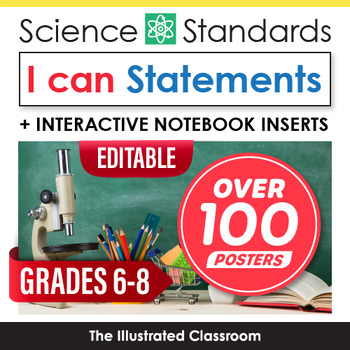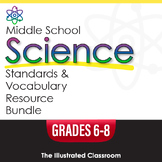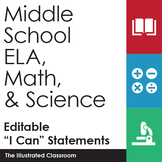Middle School Science I Can Statements NGSS Classroom Focus Target Wall Bulletin
- Zip
What educators are saying
Also included in
- Bring middle school science to life with this powerful bundle of editable middle school science NGSS-aligned resources. The color-coded I can statements are just what you need for showing students, parents, and administrators the standard at the heart of your lesson. The word wall cards and crossworPrice $23.19Original Price $52.70Save $29.51
- Bring middle school ELA, Math, and Science standards to life with this bundle of editable I Can Statements. The plain language and illustrated examples make the standards easier for everyone to understand.Price $61.16Original Price $67.95Save $6.79
Description
Bring the NGSS science standards to life with these easy-to-use, color-coded, editable posters for middle school science. They are perfect for showing students, parents, and administrators the academic standard that is at the root of your lesson. The illustrations and kid-friendly "I Can" Statements help students make sense of the standards. The full-page and half-page sizes are ideal for bulletin boards, interactive notebooks, homework packets, learning target displays, and more. Check out the free preview for an up-close look at this middle school science standards resource.
WHAT'S INCLUDED
Editable
- Full Page I Can Statements
- Half Page I Can Statements (2 per Page)
- Half Page I Can Statements for Printing Custom Sizes
Ready to Print
- Full Page I Can Statements
- Half Page I Can Statements (2 per Page)
- Half Page I Can Statements for Printing Custom Sizes
- Interactive Notebook Inserts
- Printing Instructions
CONTENTS
There is a poster for every standard in the middle school NGSS. The posters are organized according to these Disciplinary Core Ideas
- MS-PS1 Matter and its Interactions
- MS-PS2 Motion and Stability: Forces and Interactions
- MS-PS3 Energy
- MS-PS4 Waves and their Applications in Technologies for Information Transfer
- MS-LS1 From Molecules to Organisms: Structures and Processes
- MS-LS2 Ecosystems: Interactions, Energy, and Dynamics
- MS-LS3 Heredity: Inheritance and Variation of Traits
- MS-LS4 Biological Evolution: Unity and Diversity
- MS-ESS1 Earth's Place in the Universe
- MS-ESS2 Earth's Systems
- MS-ESS3 Earth and Human Activity
- MS-ETS1 Engineering Design
DESCRIPTION
These middle school science standards posters "unpack" the NGSS standards and grab the attention of your students. On some, the illustration is very detailed to provide a visual for every aspect of the standard. On others, the illustration captures the spirit of the standard and piques students' curiosity. Some of the illustrations have an illustrative style while others are realistic and scientific. There are maps, charts, and diagrams from governmental science institutions like NASA, the National Climatic Data Center, and the U.S. Geological Survey (all used with permission).
Each statement begins with "I can...". The language of the standard has been simplified when possible. If you wish to simplify it further, editable versions are included.
Everything in this bundle can be printed on letter size (8.5" x 11") paper. No complicated cutting is required. To save paper, there are two posters on each page. You just have to cut one time down the middle of the page to separate the posters.







